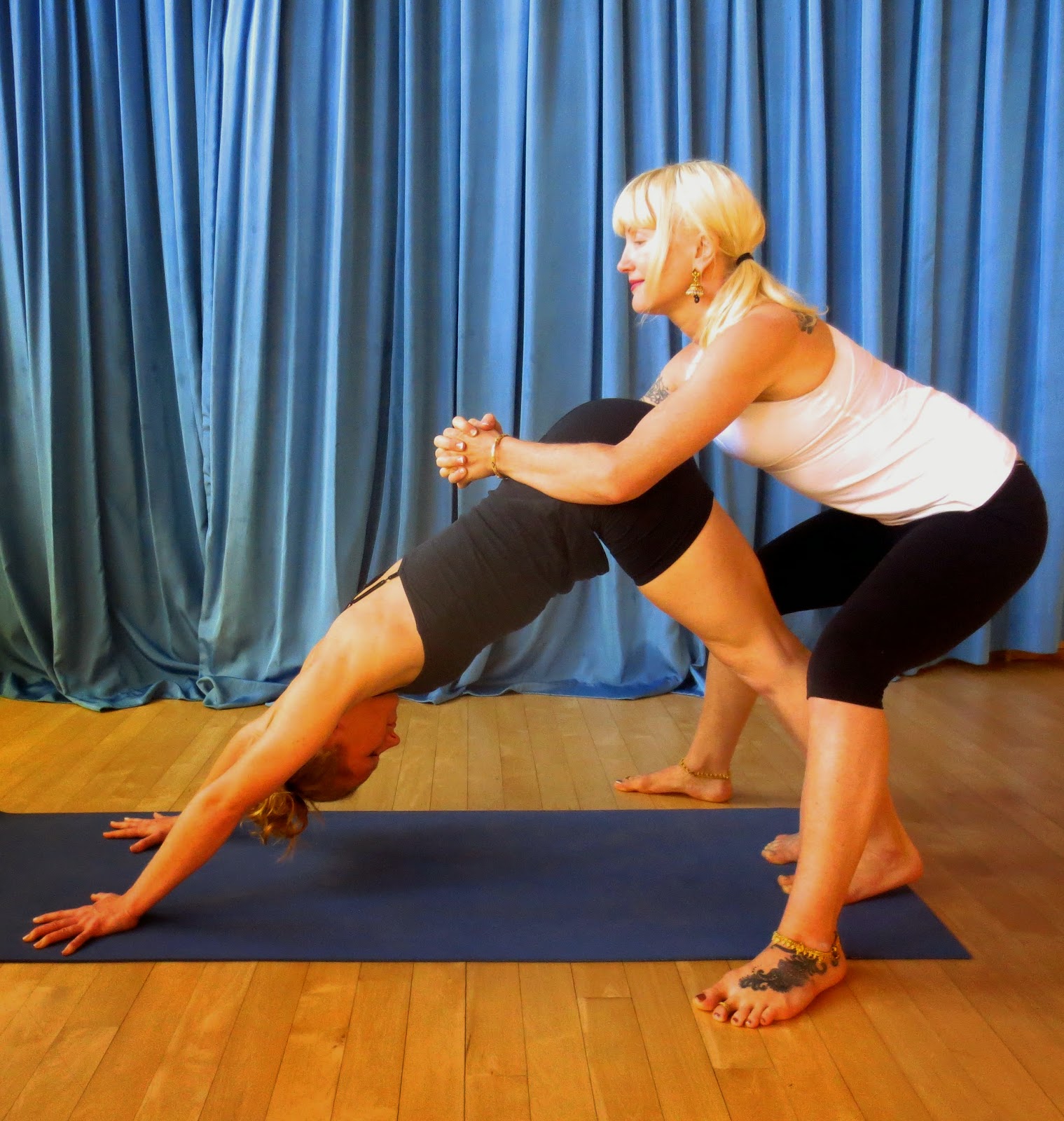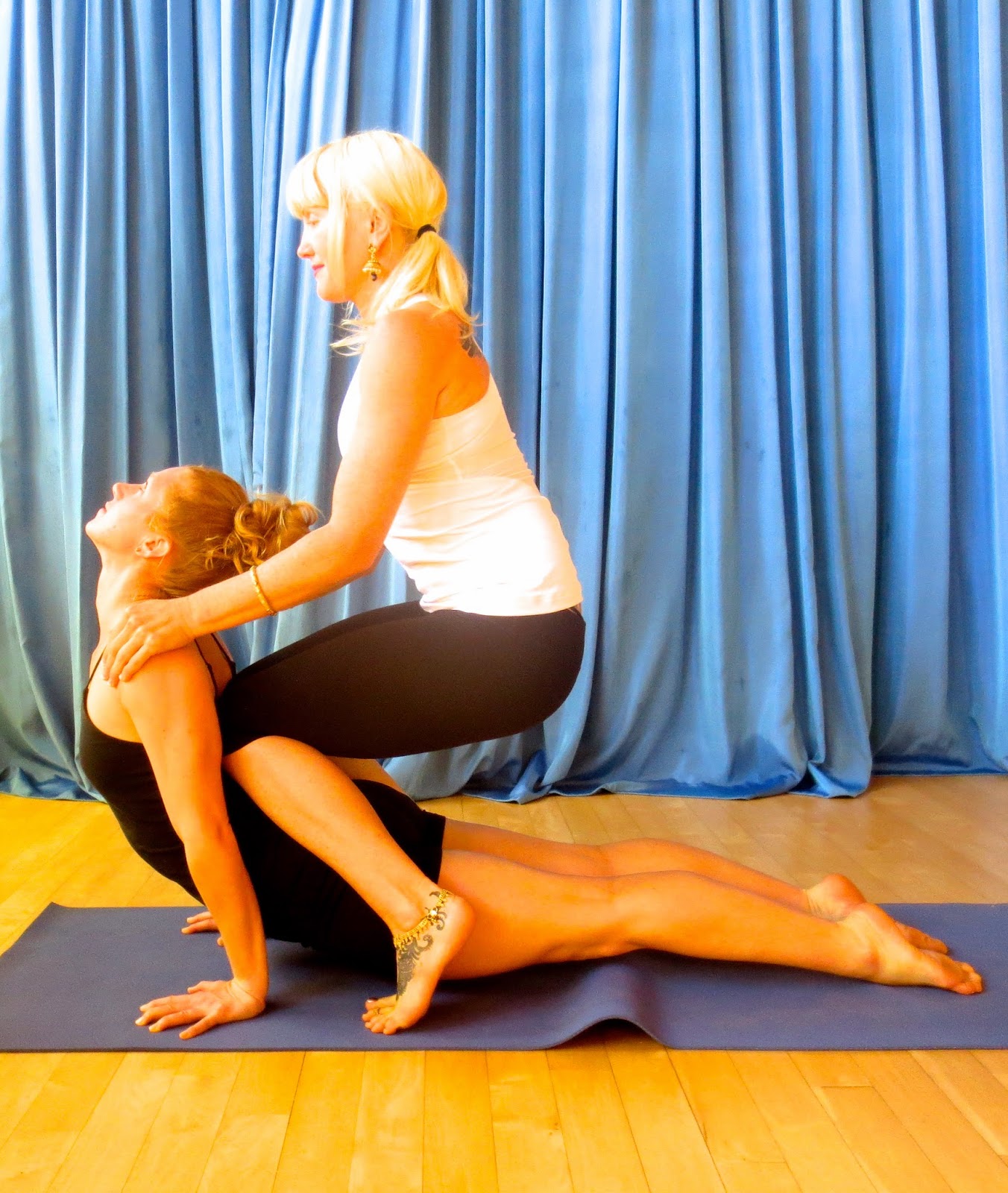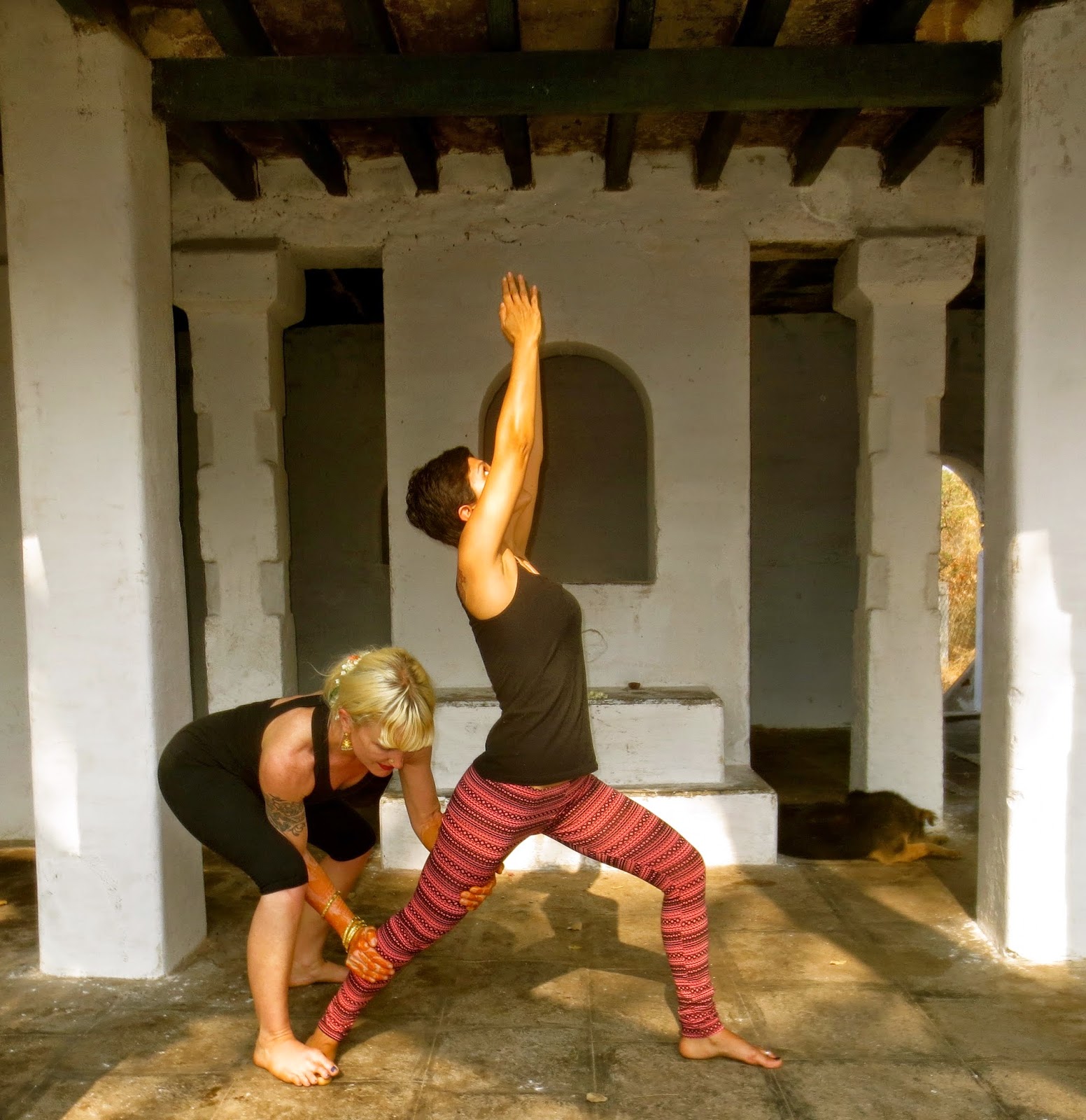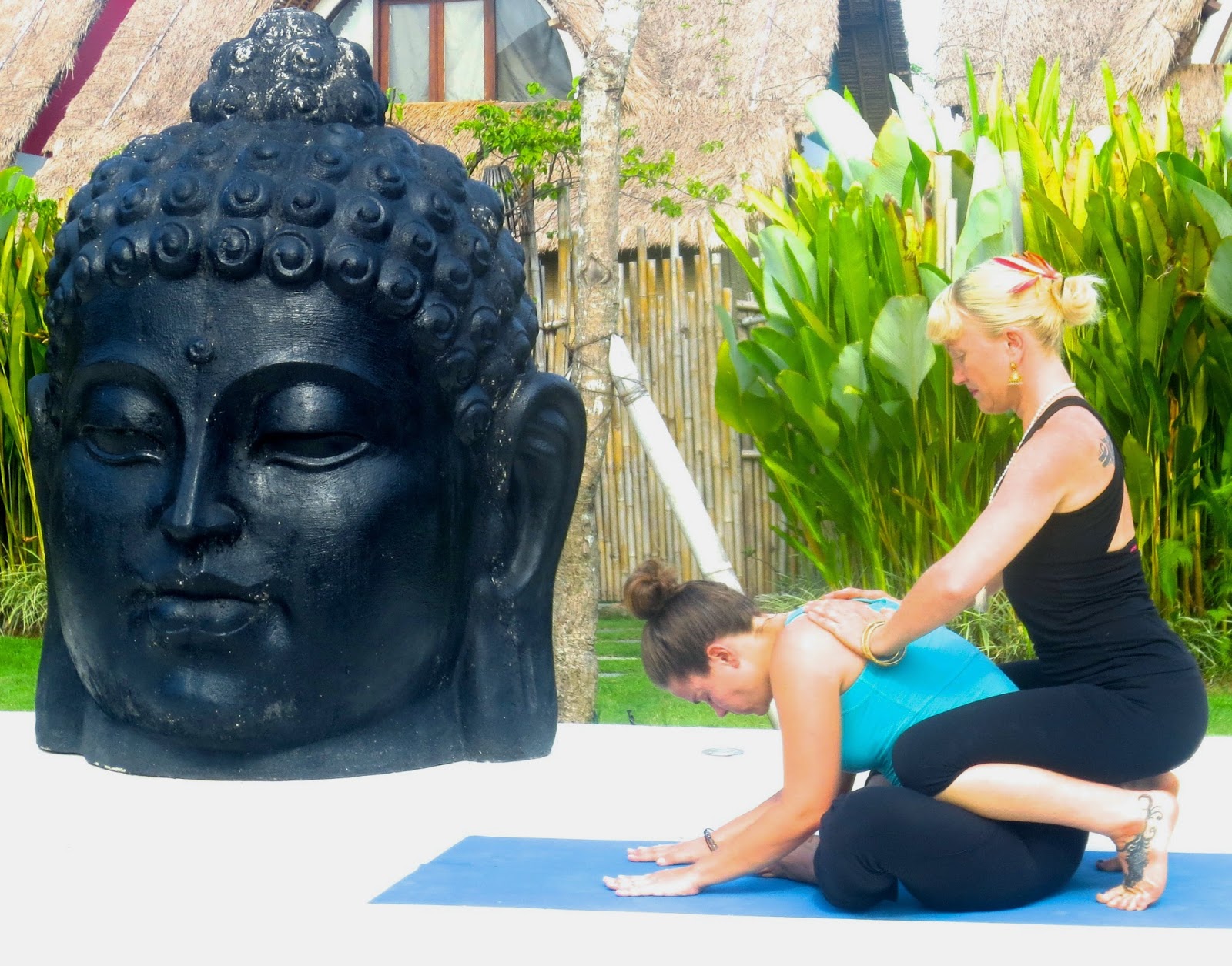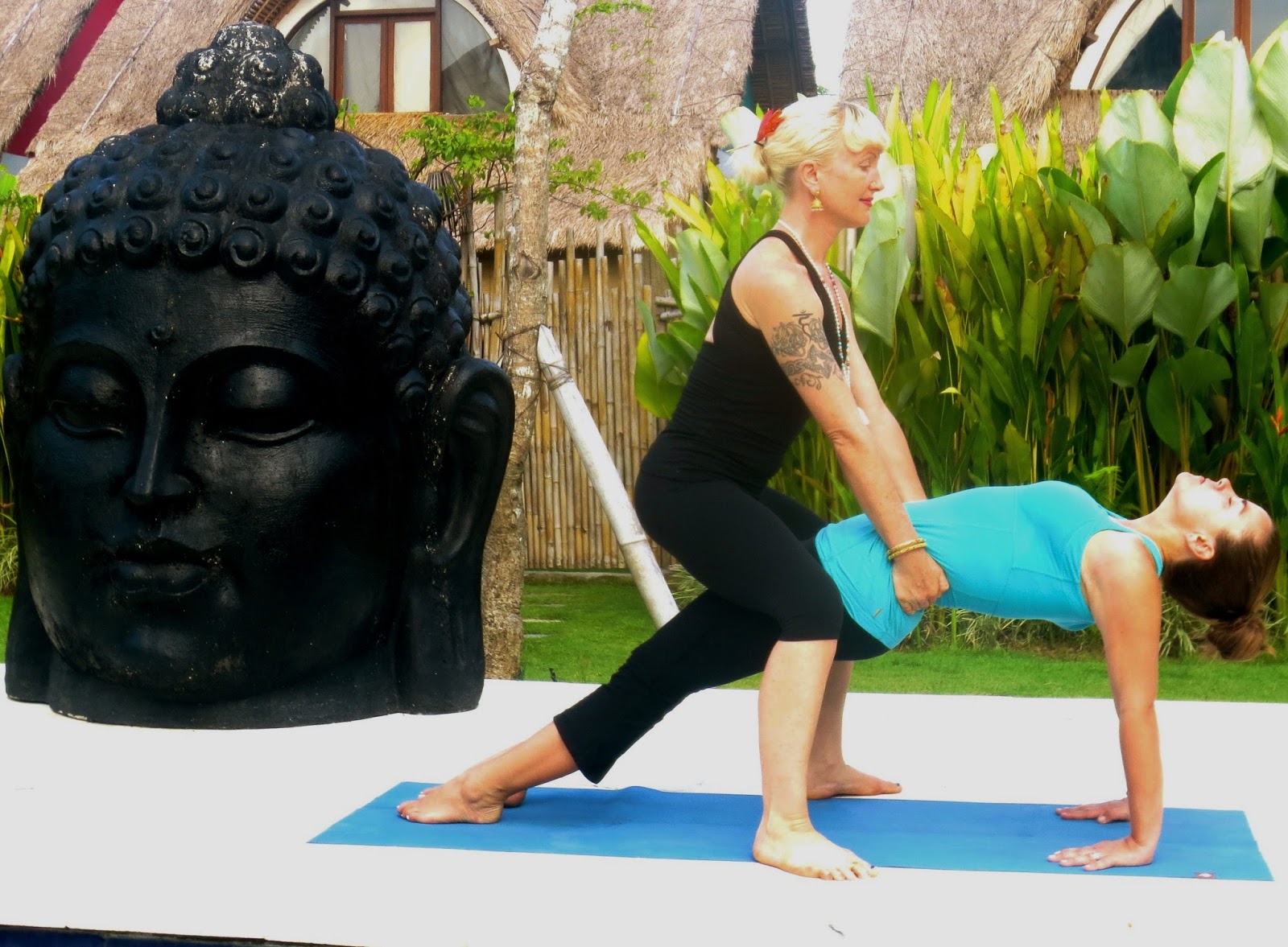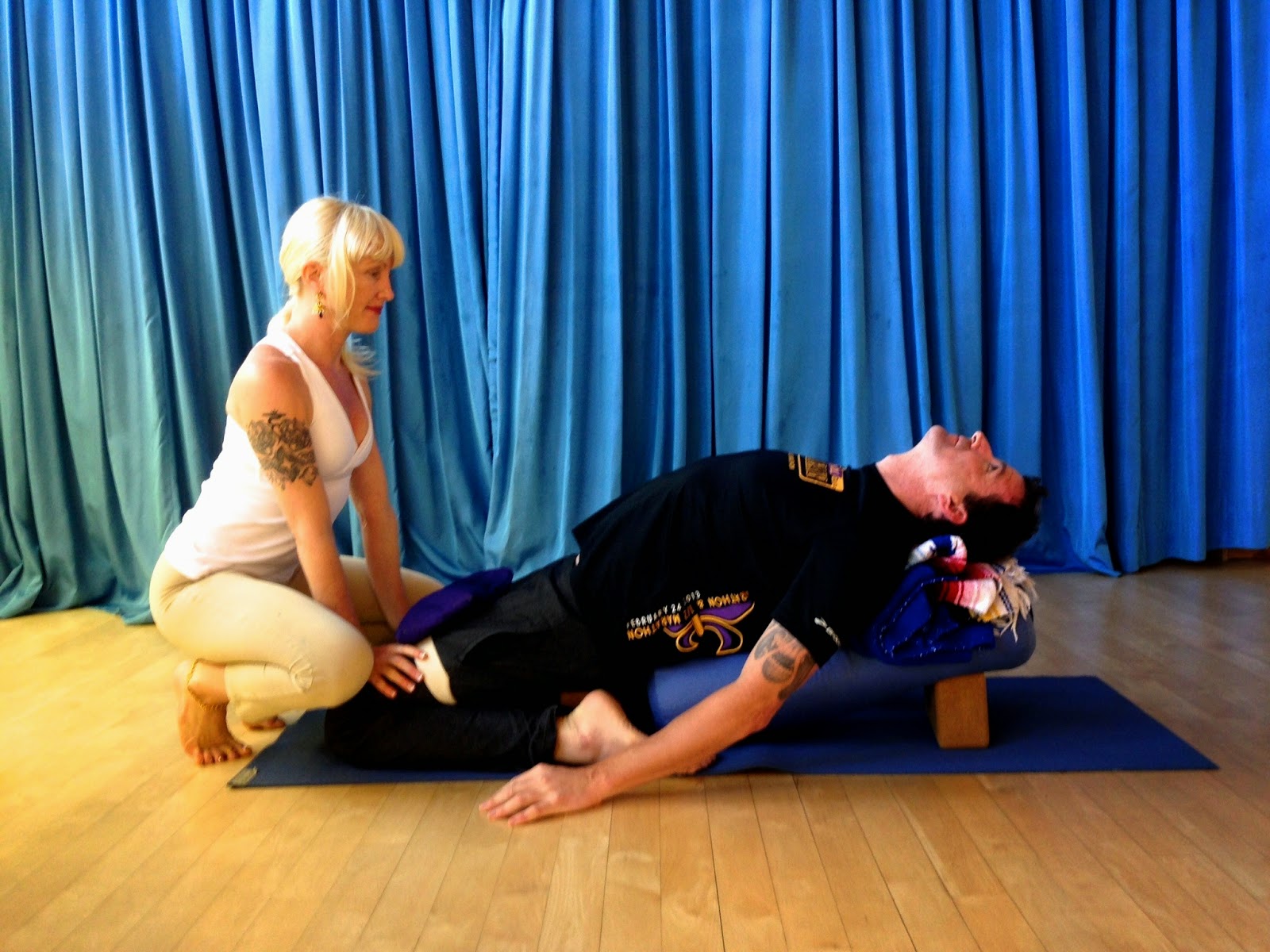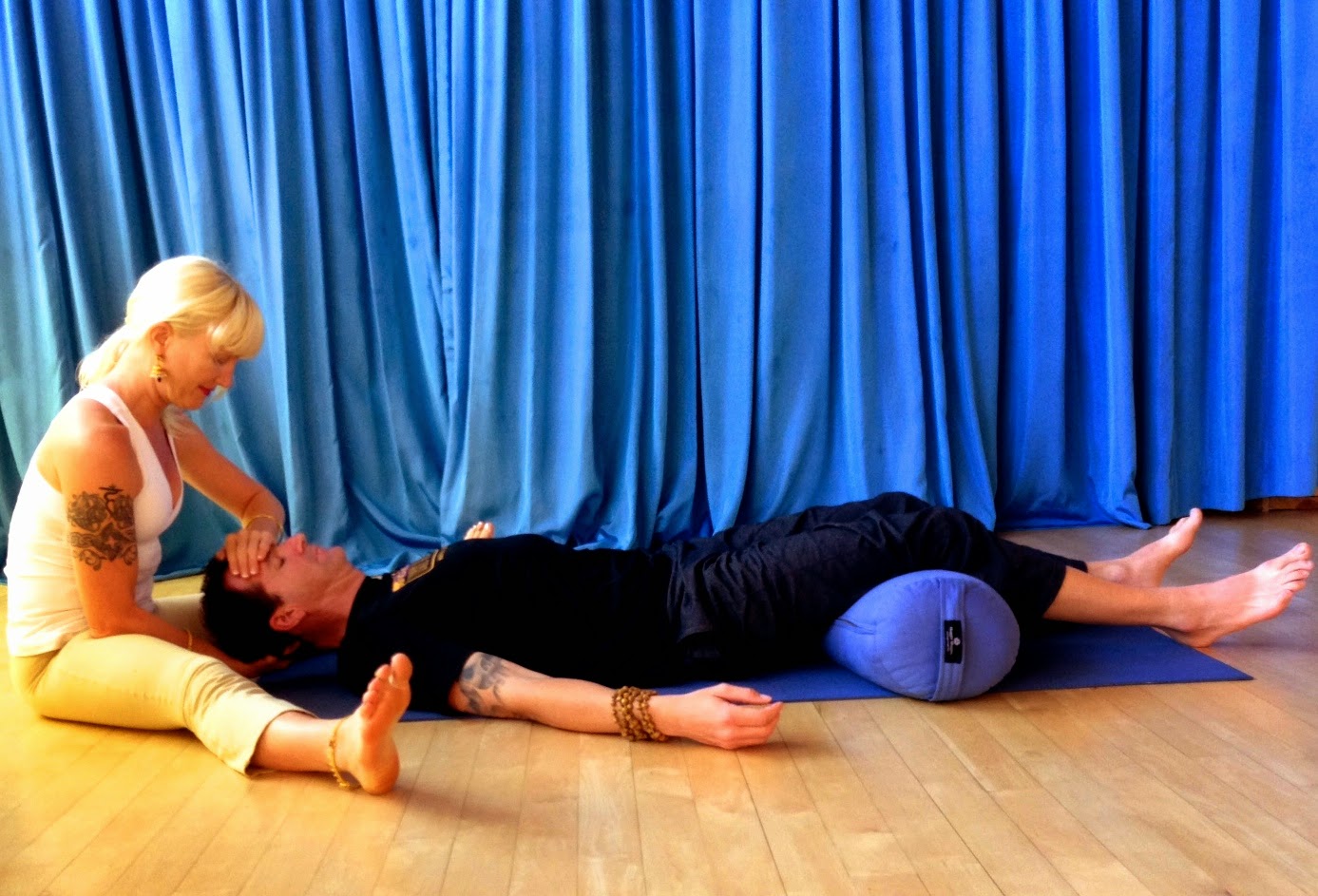Michelle's personal insights as she travels, in and out. A yoga teacher, energy practitioner, mantra singer, musician, lover... this is an offering of personal revelations on teaching yoga, singing, offering bhakti, meditating, practicing yoga, energy work, ritual and spirit. Michelle is a lover of the Divine, community gatherer and world roamer. Born on Saint Valentines Day, her most humble goal is to ignite, inspire, adore, offer and to be Love itself.
Apr 11, 2014
Asana Lab: Alignment Observation, Eagle Eye, Verbals Assists and Physical Assists
Asana Lab
Alignment Observation, Eagle Eye, Verbals Assists and Physical Assists
Alignment Observation, Eagle Eye, Verbals Assists and Physical Assists
Intelligence, Stability and Connection
3 things are taking place in all observation in a yoga class…
Approach.. The " A" of Aum (OM) is Intelligence. Proficiency, Technique, Efficacy & Skill, Understanding, Sensitivity in approach.
Remain. The "U" of Aum is Stability. Direction, Certainty, Reliability, Anchoring, Informing.
Depart. The "M" of Aum is Connection. Understanding, Clarity, Trust, Art, Nurturing, Care, establish a deeper connection with the student.
This is a simple guide for asana yoga teachers for numerous styles of yoga that provoke & inspire the use of verbal assists eagle eye & hands (feet, knees, head, etc) on assists as a means of healing, informing and getting students into the potential of their unique body while you as the teacher are sure to understand & become sensitive to just what that is.
Asana Lab takes place in every classroom setting. It is the unique way in which a student clearly observes what the present is for the overall classroom as well as the individual student as being unique, conditional, seasonal & ever-changing.
The means in which an Asana Lab can be expressed is:
1. Global Eagle Eye: observing the current mood of the overall setting due to the energy of the day, the alignment of the stars, news in mass media, holidays, time of week, time of day and type of population of class. Adjust accordingly. This is where a teacher begins to sense the group collective as well as to move the energy of the room, looking from all angles and corners of the room without touching anyone but thoughtfully making the approach inward, closer to their energic boundary as to begin shifting the energy of the room.
2. Personal Eagle Eye: observing the current mood of each student from the neutral canvas of Tadasana mountain pose (or seeing mountain pose in every pose), move sequentially in order, free of preference in students. In eagle eye observation, a teacher observes the state of a particular student from all angles, getting side profiles, sensing their mood of today, what their body is saying today, where their patterns are in the way in which they hold their body up and what they need to address. Note if they have injuries or are going through clear life changes. A body is like water. It changes daily. Adjust accordingly. This is where you respect and understand their particular canvas & begin to develop compassion and empathy as to have taken the time to notice them specifically.
3. Verbal Assists: Working sequentially, this is where you opt to give verbal cues and clear articulation to a student as to assist them in feeling a pose for themselves and making the correct adjustments. This invokes greater Self awareness. This is a very empowering tool. It is done in positivity, sequential clarity and directness so that you have time to move on to the next student. As a teacher, work on editing your language so that you are succinct and concise as to be sure your message is understood. Once you find language that fires up a response, repeat it.
4. Physical Hands On Assists: Working sequentially, this is where you assess that touch would be informative or helpful as to offer them greater depth and clarity. This is done with the permission of the student. It is never the same, robotic assist after assessing what they need that day.
Most humans, due to past suffering of the pains of relationship, sexuality, intimacy, or even trauma, can possibly have many barriers and walls that a teacher must perceive and have great sensitivity to. Always give the student the free will and power to choose or not choose touch. Use assist cards to place the power into the students hands.
In a classroom setting, when given permission, it is a profound and sacred opportunity to break those walls down so that they are unveiled. The "art" of hands-on assists, when appropriate, can be mutually beneficial, getting us all more open & alive more quickly. All relationships should be mutually beneficial and symbiotic. The teacher will get the chance to learn just as much about you and body types in general by getting in there with you as you as a student learn from the information the hands of the teacher wish to convey to you without speaking. Often, no talking is what a student needs, dropping out of the mind and into their body.
The means in which an Asana Lab can be expressed is:
1. Global Eagle Eye: observing the current mood of the overall setting due to the energy of the day, the alignment of the stars, news in mass media, holidays, time of week, time of day and type of population of class. Adjust accordingly. This is where a teacher begins to sense the group collective as well as to move the energy of the room, looking from all angles and corners of the room without touching anyone but thoughtfully making the approach inward, closer to their energic boundary as to begin shifting the energy of the room.
2. Personal Eagle Eye: observing the current mood of each student from the neutral canvas of Tadasana mountain pose (or seeing mountain pose in every pose), move sequentially in order, free of preference in students. In eagle eye observation, a teacher observes the state of a particular student from all angles, getting side profiles, sensing their mood of today, what their body is saying today, where their patterns are in the way in which they hold their body up and what they need to address. Note if they have injuries or are going through clear life changes. A body is like water. It changes daily. Adjust accordingly. This is where you respect and understand their particular canvas & begin to develop compassion and empathy as to have taken the time to notice them specifically.
3. Verbal Assists: Working sequentially, this is where you opt to give verbal cues and clear articulation to a student as to assist them in feeling a pose for themselves and making the correct adjustments. This invokes greater Self awareness. This is a very empowering tool. It is done in positivity, sequential clarity and directness so that you have time to move on to the next student. As a teacher, work on editing your language so that you are succinct and concise as to be sure your message is understood. Once you find language that fires up a response, repeat it.
4. Physical Hands On Assists: Working sequentially, this is where you assess that touch would be informative or helpful as to offer them greater depth and clarity. This is done with the permission of the student. It is never the same, robotic assist after assessing what they need that day.
Most humans, due to past suffering of the pains of relationship, sexuality, intimacy, or even trauma, can possibly have many barriers and walls that a teacher must perceive and have great sensitivity to. Always give the student the free will and power to choose or not choose touch. Use assist cards to place the power into the students hands.
In a classroom setting, when given permission, it is a profound and sacred opportunity to break those walls down so that they are unveiled. The "art" of hands-on assists, when appropriate, can be mutually beneficial, getting us all more open & alive more quickly. All relationships should be mutually beneficial and symbiotic. The teacher will get the chance to learn just as much about you and body types in general by getting in there with you as you as a student learn from the information the hands of the teacher wish to convey to you without speaking. Often, no talking is what a student needs, dropping out of the mind and into their body.
*Note...Think sequentially. What is the priority and what are common anatomical mis-alignments in the many diverse body types and variance of poses....Here, the pelvis has a tendency to tilt forward in Virabhadrasana II, so broadening spiral of the legs outward creates a space that informs the top of their pelvis back to move back, realigned. Working things out sequentially, they can then lower their hips so they are straight across from the forward knee, as Virabhadrasana II is a wonderful pelvic alignment pose.
Why Alignment Observation, Eagle Eye, Verbals Assists and Physical Assists?
I have found I learn faster and can work with greater depth and focus on my unique canvas, the body, with these 4 considerations that we call Asana Lab. I have also found as a teacher that I get closer to the students, get into a deeper level of compassion for their struggle and all human struggle, and unite in more profound relationship when they see me working hard to be with them and assist them, be it energetically, verbally, or with hands on assistance.
The focus on these 4 components of Asana Lab in a classroom can inform students quickly of both obvious gross forms of poses & micro alignment details of various asanas without using so many words. There is something strikingly profound and honest about economy of our words and speech, being succinct and cutting out chatter, editing what does not need to be said all together and just being in the physical experience with them.
I also enjoy & we will discuss the art of vocalization, articulation, positive speech & direct speech with 5 Bindhu's that we utilize to call out the names of all poses quickly with a dynamic & creative voice. Voice comes in many forms in yoga, be it singing, mantra, philosophical discussions and dialogue, inwardly and outwardly. Verbal assists are perfect spearheads of thoughtful triggers for narrowing down the needed energetic release in each asana.
I also enjoy & we will discuss the art of vocalization, articulation, positive speech & direct speech with 5 Bindhu's that we utilize to call out the names of all poses quickly with a dynamic & creative voice. Voice comes in many forms in yoga, be it singing, mantra, philosophical discussions and dialogue, inwardly and outwardly. Verbal assists are perfect spearheads of thoughtful triggers for narrowing down the needed energetic release in each asana.
In my teaching experiences of all various cultures, ages, abilities and body types (all physical things), physical understanding & communication is an approach that often gets the students into their bodies more quickly.
Hatha Yoga and the path of asana is a “marg” (path) is a physical experience. As yoga teachers, get in there physically with the students and actually do something... “act” with them in their efforts. As students work on their physical poses, energy and memory is activated or released. This means these accessing these tools as a teacher also becomes psycho-kinetically, karmically liberating and spiritually enhancing experience. Our Asana Lab tools can be a gateway for weaving into all of the sheaths, or koshas of the body, beginning with the thickest, most gross form layer, the “Annomaya kosha", the “food” body.
Yoga itself means to yolk and to create union. Yoga is the art of relationship. All things are in relationship. The art of Asana Lab gets both the student and the teacher into right relationship and to work out relationship barriers or fears as it is far more intimate and therefore must be far more respectful, committed, sensitive and thoughtful. Coming into a circuitry of symbiosis with another being in healing endeavors is very liberating for both parties. It can help bring all things into right relationship within our physical lives, all of us benefitting.
Most humans perceive, relate and understand experiences through their minds alone so the energy is often very activated in their heads where they are unable to disperse nor relate the experience throughout the full conduit of the body (a microcosm finite version of our lives). Healing the physical experience can access specific emotions, thought forms, subtle energy body shifts, intelligence, detailed alignment, karmic patterning, memories, habits, imprints & profound connection in the entire reservoir of the body. Noting just what they need by understanding Universal alignment due to your sensitivity encourages their growth and evolution.
* Note...Uttita Hasta Padanghustasana. Do what best serves THEM. Do not be tentative in their balancing pose. Instead, either move out of the way or get in there right away with grounded confidence. Balancing poses are about strengthening our focus. Since they are concentrating more, if you are nervous, the thought waves are felt and it will throw them off. Like a Mother, get in there and assist whatever they need right away without thinking about it.
* Note...Uttita Hasta Padanghustasana. Do what best serves THEM. Do not be tentative in their balancing pose. Instead, either move out of the way or get in there right away with grounded confidence. Balancing poses are about strengthening our focus. Since they are concentrating more, if you are nervous, the thought waves are felt and it will throw them off. Like a Mother, get in there and assist whatever they need right away without thinking about it.
These 4 components of Asana Lab conveys a “Mother energy” as we call it in Thai Yoga Massage. It offers a stable nurturing care and urgent concern, telling the student, free of words, that you are there for them in every possible way. Conscious awareness of what a student needs in their asana to undo discordant patterns is a supportive and nurturing biological need. This Mother energy goes past the physical body and into the energy body, or "nadis"... small river streams of pulsation flowing through you. These rivers and their points, called "marmas" begin to flow again more quickly when activation is assisted by another.
The Asana Lab 4 ingredients enhance the nervous systems communication of the mind/body connection as well as revealing a deeper sense of happiness, self esteem, being needed and fulfilled. Observing the unique canvas of the body finitely daily give longevity to a students capacity, slow down the aging process, undo unskillful lifestyle choices, offer them mastery of their habits, will strengthen the immune system, settle the nervous system, increase in endorphin levels, help one sleep better, decreased blood pressure & activate dormant or atrophied muscles for greater ability & mobility. Beings lacking touch can be susceptible to neurological disorders, an incapacity for brain neurons to fire up & often suffer from depression, memory recall & lower intellectual abilities.
In regards to touch and skillful hands on assists specifically, this may be an appropriate teaching tool if listening does not seem to evolve a student as of yet. It can heighten great depth and understand if and when a student gives permission for this and when they are ready. Consider this when approaching a student with this teaching tool. Our skin is the main boundary to our inner world and touch relates most directly to the nervous system, connecting it with the outer world. In the chakra system, touch is related to the heart chakra, the Anahatam. This is the realm of unconditional love, interconnection, humanity and service.
This is the best place to approach our sincere offering and profound understanding of asana to a student and just how transformative it can be, to serve them with the sensitivity of the heart. The proof is then no longer in the words alone but in walking the talk, in actually feeling it in every cell of our body. With these tools in our Asana Lab, the compassionate jewel of the heart is actuated in being closely with another in full trust. As yoga teachers, being committed to this physical activation adds a whole new level of fulfillment to the experience of teaching as it does to the student's practice when they are ready to receive.
This is the best place to approach our sincere offering and profound understanding of asana to a student and just how transformative it can be, to serve them with the sensitivity of the heart. The proof is then no longer in the words alone but in walking the talk, in actually feeling it in every cell of our body. With these tools in our Asana Lab, the compassionate jewel of the heart is actuated in being closely with another in full trust. As yoga teachers, being committed to this physical activation adds a whole new level of fulfillment to the experience of teaching as it does to the student's practice when they are ready to receive.
* Note...VirabhadrasaVirabhadrasana I... The assist is not always the obvious one. Work in a sequential order from the foundation up with your eagle eye drishti. You must look at their skeletal frame and not just their physical flesh and musculature to note if they are in proper alignment. If you have assessed their foundation to be secure and correct to the best of their current ability, then begin to move up to more peripheral parts of the body, as in this case, the arms. Even here, I am taking her thigh back by sitting on it when lifting her up.na The assist is not always the obvious one. Work in a sequential order from the foundation up with your eagle eye drishti. You must look at their skeletal frame and not just their physical flesh and musculature to note if they are in proper alignment. If you have assessed their foundation to be secure and correct to the best of their current ability, then begin to move up to more peripheral parts of the body, as in this case, the arms. Even here, I am taking her thigh back by sitting on it when lifting her up.
Guide line for teachers… ( encouraged at Swan River Yoga)
Understand your presence and it’s affect on the environment.
Your vibration as a human resonator is what you bring to class. Powerful teachers that take their “seat” (“asana” in Sanskrit) in a classroom have done many personal acts of physical purification so their temple of body is well received in the physical experience. In general, I do my morning puja offerings & rituals, mantra singing, meditation & asana BEFORE I teach so I am as clear as possible & have no fear or barriers within me so that I too can get close to others right away.
An important factor before entering then in with them is to align your breath. Be a wonderful example of proper breathing in the classroom setting, particularly when entering into their personal space, yoga mat, and energy field.
Purpose of Eagle Eye: To remember the big picture first as to see every detail with a Shiva Drishti.
1. Walk entirely around the room and entirely around/near each and every person. *Notice the mood, ability & level of ALL the students.
2. Notice their breath.
3. Look for their dosha (Ayurvedic constitution favoring either air, fire or earth/water)
4. Take clear actions or no actions (also purposeful) at all.
*Notice overall (global) and individual Gross Form misalignments Example: they are on the wrong leg or wrong pose
*Notice overall (global) and individual Gross Form misalignments Example: they are on the wrong leg or wrong pose
5. Notice common, entire classroom (Global) & individual anatomical misalignments (imbalanced hips, shoulders, spinal curvatures, lordosis, hyper-extenders, flat necks, rib cage sticking out, leaned to one side, weight in knees, size of ankles)
6. Notice common/global & individual misalignments (Alignment is more detailed than Gross form & takes an even more keen, refined eagle eye. See their skeletal system. Not just their flesh or periphery) of individual poses. Example: Trapezius shortening the neck. Chin (hyoid bone) popped forward. Leg hyper-extends with knee in front of ankle.
7. Look at Alignment according to how your dharma talk relates to a specific body part or where it is you choose to focus your alignment awareness for the day as to narrow down the infinite possibilities. Example again: Dharma talk on Prema. Alignment of heart. Look at all of their shoulders, biceps, forearms, wrists, hand placements.
Purpose of Staging: For you to position yourself properly so you can see them and they can see you in physical dialogue.
1. Stay interactive with the students. You are in conversation. Do not sit down. Be sure when addressing them with sequence and transition, whenever possible, they can see you before you make a personal hands on assist. Example: Side plank, Vashistasana Right side: Walk over to the right side BEFORE this pose happens so once then get into it they see you talking to them face to face.
2. Just like a theatre performance rule, do not turn your back on them as a whole. It would be such a rare case that you would need to do this.
3. See them. When using your eagle eye, from time to time walk to places where you can see the best view of all of their bodies just as though you were watching a demo of a yoga pose.
4. When they are balancing, do not move and get out of their peripheral vision/drishti.
When you personally have set a stable foundation for yourself it will be safer for both you and them. Then you will have the confidence required to take them deeper into things and more advanced poses. They will sense this too. They must trust your grounding & skill for optimal efficacy. Your job is to notice when it is time for a student to advance and how far to take them. They are counting on you to notice this and to be the one to guide them securely.
When you personally have set a stable foundation for yourself it will be safer for both you and them. Then you will have the confidence required to take them deeper into things and more advanced poses. They will sense this too. They must trust your grounding & skill for optimal efficacy. Your job is to notice when it is time for a student to advance and how far to take them. They are counting on you to notice this and to be the one to guide them securely.
Sequential Order of Hands on Assists:
1. Gross form misalignments are first. Example: serious safety issue, wrong leg or wrong pose. (Gross form mis-alignments are always address first before micro detailed Alignments)
1. Gross form misalignments are first. Example: serious safety issue, wrong leg or wrong pose. (Gross form mis-alignments are always address first before micro detailed Alignments)
2. Eagle eye the foundation. If the foundation is off. Go no further. It’s like building a house on swampland.
3. If the first 2 are in check, determine BEFORE your class starts and as part of yourthe link to your dharma talk, HOW your dharma talk will relate to an anatomical theme. Example: A love SuPrema is my dharma talk. I will focus on heart alignment in my verbal instruction. I will focus on heart alignment for my hands on assists.
4. Once the body part is narrowed down, eagle eye each person individually. They do not all need the same heart hands on assist. Look first and then decide what will optimally serve them specifically the most so it is never a mechanical adjustment.
5. In general, go from Gross to Subtle and from the Source (mid-line, shoulders and hips) to the periphery of the body. Example: Do not adjust the arms and hands if the shoulders (the Source of the shoulders and hands) are out of alignment, rolled forward.
6. Move in order. One person at a time in each row, one person followed by another. Then there is no preference, specialness or self consciousness of the student. Provoke order. Go in order. Remember and go back to the other side, in order.
Understand the effect your presence has on them and ensure them of a symbiotic, empathetic approach. Parsva Utitta Hastapadanghustasana.
Understand the effect your presence has on them and ensure them of a symbiotic, empathetic approach. Parsva Utitta Hastapadanghustasana.
“Vikeka”; Practice Discernment:
First, see where the “Tadasana” (mountain pose)/Samasthiti (equal standing pose) canvas is in every pose.There is great intelligence in nurturing. The greater skill you have the greater freedom they have the chance to embody.
Here is a check list:
1.Discern your economy of time. The goal is that everyone gets touched or personally addressed energetically in some way. This is my personal goal and I am always a bit disappointed if someone is left out. If you were the Divine Mother, would you leave even one sacred precious being out?
This will help you determine how much time you give each person so that you do not get too extravagant in your giving to a few.
2. Know what bests serves them beyond what you wanted to offer or want to give them. It is all about them. It is their time.
3. Over time, get to know their bodies and individual needs in keen, detailed observation. Do not approach everyone the same way. Know who has a shoulder injury. Know who has scoliosis, or a kyphotic spine... this type of thing. Then when you get to them, you already know what to do and not to do.
4. Note mood and attitude…see when someone is in a particularly unusual mood.
5. Note particular body types…Organic or Muscular… for possible injury prevention. In general, more organic or flexible yogis injure themselves far more easily. In general, Vatta Dosha (those with a lot of air in their constitution) are sensitive to touch due to their nervous system and have thinner skin. Because of this, do not push vattas quickly.
6. Discern right away if you are actually assisting them or throwing them off. If their breathing changes, if they contract, if the energy shifts with many walls up, back off immediately. Remain humble and caring.
7. Discern if they need you to actually assist them into it more or if what serves them is to make it more challenging. Beyond being incorrect assists all together according to a good understanding of anatomical alignment, I also often receive assists that I do not really need nor do I understand what they were trying to tell me.
8. Discern and know correct use of props and prop suggestions. Often they will not know until you tell them. Props bring the earth to the practitioner. Just like anything in the earthly realm, they come and they go.
9. Are they getting it? Discern whether they are actually getting what your hands are saying. If not, you may need to either adjust your assist or verbalize something (as little as possible and by being direct) with them so they understand.
10. Note when someone does not want to be touched and simply do not touch them at all.
10. Discern yourself. Break out of standard routines that you may have habituated.
*Ask yourself... WHY am I doing the assist that I am doing? Am I going through motions or is this purposeful? Be sure you have a good answer that serves the student in the Highest.
*Ask yourself... WHY am I doing the assist that I am doing? Am I going through motions or is this purposeful? Be sure you have a good answer that serves the student in the Highest.
Types of Assists:
1. Quick informative tap. Example: Tap the quadriceps instead of constantly repeating verbally “activate your quads”. Example: tap the right leg when you articulated “right leg forward but they brought their left leg forward. Example: Tap the knee if it rotates in/out in in Warrior II.
2. “Vayus” (winds) of the body. Know how energy flows in the pranic body(the pranamaya kosha)... down, side to side, spirals, up & all pervasive). Remember, the Energy sheath is the next less dense sheath or kosha interweaving into the physical.
1. Quick informative tap. Example: Tap the quadriceps instead of constantly repeating verbally “activate your quads”. Example: tap the right leg when you articulated “right leg forward but they brought their left leg forward. Example: Tap the knee if it rotates in/out in in Warrior II.
2. “Vayus” (winds) of the body. Know how energy flows in the pranic body(the pranamaya kosha)... down, side to side, spirals, up & all pervasive). Remember, the Energy sheath is the next less dense sheath or kosha interweaving into the physical.
3. Moving with the energy. Some physical assists move with the practitioner. These assists typically bring them more deeply into the pose. Example: grounding their thighs into the earth and pushing their spine where it the most stuck forward in a seated forward bend.
4. Moving against the energy. Some physical assists push against the practitioner. These assists are typically to challenge them more. Example: Pushing into their foot in Virabhadrasana III. *NOTE: Many assists that push against them need verbal cues or you are doing nothing but making it extremely difficult for them.
5. Getting down to get up. In general, you will need to root something down to lift something up when moving WITH and you will need to verbalize when pushing AGAINST.
There are many ways to assist one pose. Be careful to not fall into your own personal set ways of doing things by default. Engaging the scapula and lifting the arms for a broader chest and heart opening.
After teaching:
Keep your energy clean. Honor techniques for clearing your energy after class and every day. Keep your intention high, integrity consistent and trust of great worth. I often wash my hands right away after teaching to clear them energetically. At home a use sage, fire ceremonies and epsom salt scrubs on my hands so that I do not pick up the energies of another with mixed energy. Our Sadhana is also our greatest protection so that we are able to continue to assist sustainably.
Our teachers have taught us that our bodies are the shape of our thoughts, speech & karmas. By assisting (never “trying” or “helping”) a connection a being can become more liberated & flexible to their experiences. This will generate greater joy & sweetness (Sukham) of their lives. By encouraging & challenging students to be strong & aligned (Sthira) a steady, palpable, real life experience of the Divine takes place.
Remember, hands on physical assists is an entirely deeper level of interaction. Sometimes words can break the magic of moving the energy and shaking it off. The relationship of touch is intimate & sacred. Approach every being with an elevated mood (“bhava”) and you have the chance to assist in breaking many karmic binds of pain & suffering. Then they too can practice and BE the Ultimate Love, “Prema” in the vehicle they now carry. Nothing in maya is fixed. Just about every day, somewhere in India I here the phrase, “All is possible”. Show them this is true by the use of your hands, an extension of your heart.
Here is a library of ideas for personal hands on assists. *For more detailed explanations on how the energy is moving and how to perform the assist, come to or schedule a lecture & workshop "The Art of Hands-On Yoga Assists". (a manual is coming soon)
Vinyasa Sequence Within Surya Namaskar:
Sun Salutations where traditionally created to bow in connection with the life & light giving Source as we recognize something so stunning rising above us that we are humbled, lowering ourselves onto the ground in respect and gratitude. It is a moving prayer that we flow through too clean up our thoughts, speech and hearts. It is a full prostration using the entire body we have been given, moving any small, densely cloaked energy off of us to better align with the magic and light bearing life force that sustains us all. This helps us to remember our connection and the connection of all things in our lives to this Source, committed to it. Our bodies can then be fully embodied conduits, useful in the process of our happiness and in serving others. Surya Namaskar is a warm up. You are meant to flow and get out of our critical mind into the full body of your experience.
Some standing poses:
Standing poses are meant to ground us and establish a deeper connection to the earth. They activate the downward flow of energy within us, the "Apana" so that we are more consistent, reliable, well established and trustworthy. Standing poses build confidence, mobility and agility. They require great strength in our foundations, sequentially where it all must begin. Standing poses often require balance so focus is increased, bringing the thinking mind into the full body. This invokes more security and courage, both needed as a yogi and yogini.
Some Forward Folds:
Forward folds open the back body, known as the Universal Body, as it is less individualized. They strengthen and tonify the front body and internal organs, giving them a good squeeze. Forward bends slow the energy down and bring the energy in for deeper contemplation, groundedness and steadiness.
Some Back Bends:
Back bends open the front, individual body, where our features are more personal and more fully exposed into our outer experience, moving us forward. The back body and spine is predominantly strengthened. The energy of backbends goes faster, goes up and goes out, thus back bends tend to activate the nervous system. Backbends are governed by the leg and come from the base of the heart. The heart represents the Wisdom mind and the entire "body" consciousness we reside in.
Here is a library of ideas for personal hands on assists. *For more detailed explanations on how the energy is moving and how to perform the assist, come to or schedule a lecture & workshop "The Art of Hands-On Yoga Assists". (a manual is coming soon)
Vinyasa Sequence Within Surya Namaskar:
Sun Salutations where traditionally created to bow in connection with the life & light giving Source as we recognize something so stunning rising above us that we are humbled, lowering ourselves onto the ground in respect and gratitude. It is a moving prayer that we flow through too clean up our thoughts, speech and hearts. It is a full prostration using the entire body we have been given, moving any small, densely cloaked energy off of us to better align with the magic and light bearing life force that sustains us all. This helps us to remember our connection and the connection of all things in our lives to this Source, committed to it. Our bodies can then be fully embodied conduits, useful in the process of our happiness and in serving others. Surya Namaskar is a warm up. You are meant to flow and get out of our critical mind into the full body of your experience.
Tadasana
Kumbukasana
Chatarangadandasana
Urdhva Mukha Svanasana
Adho Mukha Svanasana
Some standing poses:
Standing poses are meant to ground us and establish a deeper connection to the earth. They activate the downward flow of energy within us, the "Apana" so that we are more consistent, reliable, well established and trustworthy. Standing poses build confidence, mobility and agility. They require great strength in our foundations, sequentially where it all must begin. Standing poses often require balance so focus is increased, bringing the thinking mind into the full body. This invokes more security and courage, both needed as a yogi and yogini.
Parvrtta Trikonasana
Parvrtta Ardha Chandrasana
Eka Pada Uttanasana
Prasarita Padotannasana C
Virabhadrasana I
Ardha Chandrasana
Ardha Chandra Chapasana
Vrschasana
Some Forward Folds:
Forward folds open the back body, known as the Universal Body, as it is less individualized. They strengthen and tonify the front body and internal organs, giving them a good squeeze. Forward bends slow the energy down and bring the energy in for deeper contemplation, groundedness and steadiness.
Dandasana Prep
Dandasana
Paschimotasana
Paschimotasana
Paschimotanasana
Badha Konasana
Badha Konasana
Janu Shirshasana
Parvrtta Janu Shirshasana
Marichasana A
Marichasana C
Upavista Konasana
Purvotanasana
Some Back Bends:
Back bends open the front, individual body, where our features are more personal and more fully exposed into our outer experience, moving us forward. The back body and spine is predominantly strengthened. The energy of backbends goes faster, goes up and goes out, thus back bends tend to activate the nervous system. Backbends are governed by the leg and come from the base of the heart. The heart represents the Wisdom mind and the entire "body" consciousness we reside in.
Setu Bandhasana
Setu Bhandasana
Setu Bhandasana
Urdhva Dhanurasana
Eka Pada Urdhva Dhanurasana
Shalabasana
Shalabasana
Shalabasana
Bhujangasana
Bhujangasana
Bhujangasana
Dhanurasana
Dhanurasana Variation
Bhekasana
Ustrasana
Ustrasana
Virasana
Kapotasana
Eka Pada Raja Kapotasana
Hanumanasana
Hanumanasana
Preparing for Drop Back
Drop back into Urdhva Dhanurasana
Preparing to come up from Urdhva Dhanurasana
Coming up from Urdhva Dhanurasana
Getting behind them in Adho Mukha Vrschasana
Stabilizing for Vrschikasana B
Dropping into Vrschikasana B
Bending legs for Vrschikasana B
Vrschikasana B
Some Inversions:
Inversions flip our world around on purpose. They activate the sympathetic nervous system just slightly so we have a chance to practice "flight our fright" in a safe setting while still remaining calm. The provoke a more daring, adventurous idea & our attitude of capability within us. They represent those times in our life when things get shaken up and give us skillful means to respond. The energy in inversions go up, in and the velocity of the energy gets faster just like the upper chakras.
Look Mom no hands (such a strong assist the hands come off the ground!)
Salamba Sarvangasana
Baddha Konasana in Sarvangasana
Padma Sarvangasana
Pincha Mayurasana
Pincha Mayurasana
Pincha Mayurasana
Vrischikasana B
Padmasana in Adho Mukha Vrschasana
Padmasana Variation in Adho Mukha Vrschasana
Adho Mukha Vrschasana Variation
Adho Mukha Vrschasana descent to Urdhva Dhanurasana
Adho Mukha Vrschasana descent to Urdhva Dhanurasana
Lifting from Prasarita Padotanasana A to Sirshasana II
Sirshasana II Split Variation
Lifting from Sirshasana II to Adho Mukha Vrschasana
Lifting from Sirshasana II to Adho Mukha Vrschasana
Lifting from Bhakasana to Adho Mukha Vrschasana
Lifting from Bhakasana to Adho Mukha Vrschasana
Sirshasana
Sirshasana Core strengh variation
Hanumanasana in Sirshasana
Salamba Sarvangasana
Salamba Sarvangasana
Halasana
Supine Poses
Supine poses tend to be more restorative and calming since so much of the back Universal body is on the ground, connecting the back of our heart with the Universal Earth pulsation. The energy will tend to slow way down so they are nice to place at the end of our sequencing. Most Supine poses also tend to be forward bend variations but there are nice restorative backbends also. Restorative poses with the use of blocks and bolsters can be held for longer durations of time, more like 10 minutes or more, for a very profound affect of linking the pace of the mind with the pace of the body.
Supported restorative back bend with bolster
Supported restorative supta badha konasana
Supta Virasana
Ardha Ananda Balasana
Supta Parsva Padanghustasana
Supta Hasta Padanghustasana
Supta Eka Pada Shirshasana
Shoulder press in Shavasana
Applying shoulder loop in Shavasana
Skull press and Reiki in Shavasana
Shavasana therapeutics
Shavasana Therapeutics… End in Pranam to them.
The most important component and attitude in hands on assists is the teacher and student's mutual respect for one another, neither one greater than the other, but both committed to upholding the depth that the role playing and intimacy brings.
Below is a protection mantra found in the Upanishad's for teachers and students in a classroom setting. It is a teachers greatest "weapon of mass destruction" of misunderstanding, lack of respect, lack of compassion, anger, jealousy, arrogance, shyness, "pedestalness", fear, & disregard of all that is sacred. It works! Sing this mantra on your way to class & you will be far better received by the students that come.
Saha Na Vava tu. Saha Nau Bhunaktu. Saha Viram Karavavahai. Tejas vi navaditam astu ma vidvishavahai. Om Shantih shantih shantih.
I offer pranams to ALL students after I teach a yoga class. Thank you. Each of you. I would be nothing without all that I have learned from them in our togetherness.
Subscribe to:
Posts (Atom)
